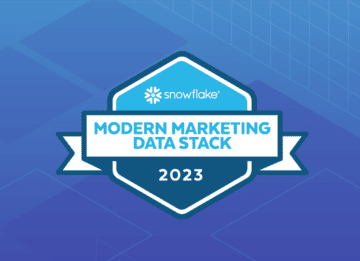
3 ways identity helps CDP users do better digital marketing
aLet’s put it bluntly—CDP customers are still struggling to use their data to improve their marketing.
Which means they’re not getting as much value as they could from your CDP (painful, in a time of tight budgets).
Gartner reports “digital marketers believe they have the right tools to aggregate and segment customer data, yet still overwhelmingly agree that leveraging customer data for digital marketing execution presents a significant challenge.”
But there’s a simple solution for that—integrate real-time identity resolution (IDR) into your CDP.
Integrating IDR gives you a fast leg up on the competition, while making life easier for your customers in a few meaningful ways.
1. Unify customer data into a single customer view
Your CDP can do some of this, but you probably struggle a bit delivering on the promise of fully unified customer data.
Let’s say a customer signed up with the brand under two different emails—can you reconcile them to a single person? If not, these two email addresses are now treated as two separate people. This often results in:
- Treating high-value customers like any old Joe Schmoe
- Sending duplicate emails to the same person
- Wasting ad spend by targeting this one person as two people
- Misinformed personalization efforts
The same thing happens when a customer provides a phone number to customer service. Or buys from you in a brick-and-mortar store. Suddenly, all of these pieces of information look like different people.
By integrating identity resolution into your solution, you can make sure all of these disparate touchpoints are connected to the real person that engaged with the brand. It works by aligning each data point to an identity graph that contains millions of identities and billions of touchpoints—all connected to real people.
Related Content: The Identity Graph—What Every Marketer Needs to Know
With the right IDR solution, you’ll be able to offer 40% more linkage and unification of customer and prospect data.
Goodbye, duplicate records. Hello, more efficient and effective marketing.
2. Identify website visitors and recognize customers
One of the biggest gaps in a CDP’s functionality is identifying unknown website visitors.
You may have:
- A bunch of email addresses from newsletter subscribers
- Phone numbers from customer support conversations
- Transactional details and physical addresses from purchases
- Handles from social engagement
But it all means nothing when an unauthenticated visitor shows up on the site. You still know diddly squat about who they are and what they’re interested in—even if they’ve interacted with the brand dozens of times before.
And this means brands can’t populate a personalized offer for products or services.
They can’t enrich the customer profile with the most recent browsing behavior.
And they can’t reach back out to this unauthenticated visitor (at least without using third-party cookies).
#marketingfail
If you want to be able to identify website visitors—even when they’re not logged in—your CDP needs to include identity resolution that resolves website visitors to a real person.
Identity resolution can help marketers to identify up to 50% more unauthenticated website visitors, automatically increasing the size of the prize when it comes to digital marketing efforts like abandonment campaigns.
The more people you can recognize, the more people you can reach—and the more people you can get back on site to buy.
3. Extend the brand’s reach with incremental identifiers
Everyone talks a good omnichannel game, but lots of marketers only have one or two identifiers for each of their customers (email, anyone?). It’s tough to execute personalized, omnichannel marketing with a single email address.
In fact, one of the biggest problems with brands’ identity resolution programs is that they rely on too few identifiers (according to a Forrester report commissioned by Epsilon).
To execute true omnichannel marketing, brands need more ways to reliably reach people online. And that means appending as many hashed emails and mobile ad IDs (MAIDs) as possible.
Integrating identity resolution into your CDP allows your platform to append these incremental identifiers to terrestrial, email, and mobile identities—increasing your users’ reach at least 300%.
Yes, you read that right…3X.
That’s one way to stand out in a crowded CDP market.
To get the maximum effect, though, you’ll want to match these touchpoints on the person-level, not cookies, devices, or households. Just think—your browsing behavior is probably a whole lot different than your partner’s, child’s or roommate’s.
A final word on CDP identity resolution
Yes, CDP customers are still struggling to use the data at their disposal. But these marketers don’t want another tool—they want to get more out of their existing tools.
Integrating identity resolution into your CDP brings your product one step closer to being that complete digital marketing solution they’re looking for.
Check out how Adobe has integrated FullContact’s identity resolution to offer incremental customer recognition in the moments that matter.
Recent Blogs
-
 September 21, 2023 Discover How FullContact is Building Trusted Customer Relationships through Snowflake's Native Application Framework Customer 360, Website Recognition, Identity Resolution
September 21, 2023 Discover How FullContact is Building Trusted Customer Relationships through Snowflake's Native Application Framework Customer 360, Website Recognition, Identity Resolution -
 September 20, 2023 Transform Your Customer Experience with FullContact Customer Recognition and Boost Your Conversions Website Recognition, Identity Resolution
September 20, 2023 Transform Your Customer Experience with FullContact Customer Recognition and Boost Your Conversions Website Recognition, Identity Resolution -
 September 14, 2023 FullContact Recognized as a Leader in Snowflake’s Modern Marketing Data Stack Report FullContact News, Partnership
September 14, 2023 FullContact Recognized as a Leader in Snowflake’s Modern Marketing Data Stack Report FullContact News, Partnership